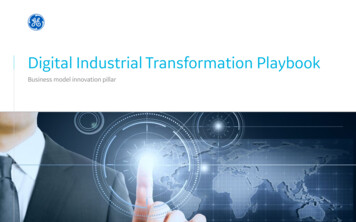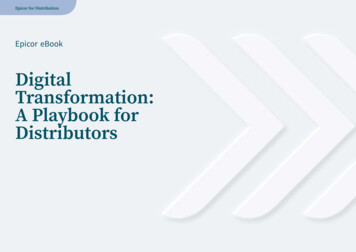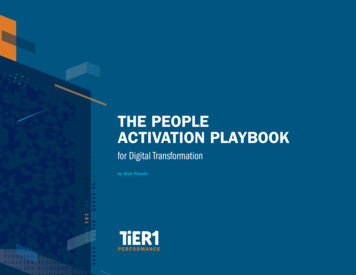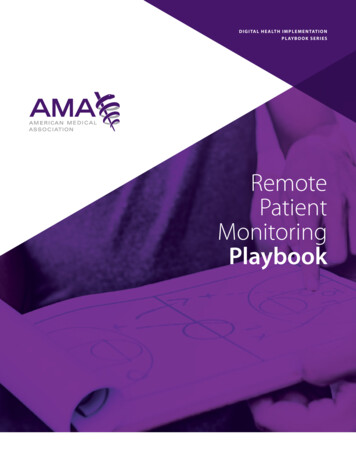
Transcription
The DigitalTransformationPlaybook for theMiddle Market
ContentsFORCES OF DISRUPTION1BREAKING DOWN DIGITIZATION, DIGITALIZATION& DIGITAL TRANSFORMATION2THE MIDDLE MARKET DIGITALTRANSFORMATION JOURNEY31. Re-Imagine Your Business42. Assess Your Current State53. Model Your Future State84. Analyze the Gaps85. Map Your Digital Transformation Journey96. Figure Out Financing107. Define the Project118. Prototype, Test and Iterate139. Prepare Your People1510. Execute and Refine16
THE DIGITAL TRANSFORMATION PLAYBOOK FOR THE MIDDLE MARKET / 1Forces of DisruptionDisruption is inescapable. If there were any lingering doubtsabout the necessity of digital transformation to businesslongevity, the coronavirus has silenced them. In a contactlessworld, the vast majority of interactions with customers andemployees must take place virtually. With rare exception,operating digitally is the only way to stay in business throughmandated shutdowns and restricted activity. It’s go digital, orgo dark.True disruption—the kind that marks lasting paradigm shiftsin the predominant way things are done—is more than atechnology story.It’s a virtuous circle in which technology innovation spawnschanges in market and competitive dynamics, and vice versa.To stay on the right side of disruption, businesses need toanticipate the signals and adapt and reinvent themselvesbefore disruption upends them.Disruption can be turned from threat to opportunity, butonly with a combination of foresight and focus. For themiddle market, that means establishing a digital strategy thatbalances the long-term vision with realistic short-term goals.TECHNOLOGY FORCESFORCES OFDISRUPTIONexplosion of data, cloud &flexible service delivery, pervasiveinterconnectivity, automationMID-MARKETBUSINESSMARKETFORCESregulatory shifts, securityrisks, globalization, changingcustomer expectationsCOMPETITIVEFORCESmobility and social, focuson cost, skill shortages, newentrants, sharing economyRead more
2 / THE DIGITAL TRANSFORMATION PLAYBOOK FOR THE MIDDLE MARKETBreaking Down Digitization,Digitalization &Digital TransformationDigitization and digitalization are often used interchangeably—but they shouldn’t be.Digitization is “going digital” in the most basic sense: converting analog informationand processes into a digital format. Digitalization goes one step further: usingdigitized information to identify new value creation opportunities and evolve theway you do business.Digital transformation is built on both digitization and digitalization. It’s the journey tobecoming a digital business, connecting the dots between digital initiatives, strategyand business enablement.Why do the nuances between the 3 D’s matter? Because getting on the right side ofdisruption isn’t as simple as making ad-hoc investments in digital technologies. Digitaltransformation happens at the intersection of technology and people—what we callthe digital interlock. The biggest reason digital initiatives fail is because of failure toadapt to business shifts and adopt meaningful, human-centric change.As you embark on digital transformation, it’s important not to conflate digitalimplementation with digital strategy. An implementation project—for example,investing in chatbot technology to automate the routing of customer conversations—is a tactic, ideally against the backdrop of a long-term strategy. In isolation, theproject should deliver immediate ROI, but it isn’t in and of itself transformational. Onthe flip side, digital strategy without implementation is like a flight route without aplane: You know where you need to go, but you’re no closer to your destination.Read more
THE DIGITAL TRANSFORMATION PLAYBOOK FOR THE MIDDLE MARKET / 3The Middle Market DigitalTransformation JourneyTHE 10-STEP GUIDE TO DIGITAL TRANSFORMATIONAssessYour CurrentStateModelYour FutureStateFigure OutFinancingDefine theProjectExecute andRefineRe-imagineYourBusinessSTARTFORESIGHT TO THE FUTURE (ONGOING)Analyzethe GapsMap YourJourneyPrototype,PrepareTest and YES YourIteratePeopleNOWe’ve said it before: The middle market needs its own digitaltransformation playbook. Large enterprises can plumb theirdeep coffers to make massive digital investments in ambitious,high-risk/high-reward initiatives or fund pet projects thatmay never see the light of day. On the opposite end of thespectrum, the startup world offers valuable lessons in leaninnovation and agile ways of working, but it’s worth notingthat 90 percent of startups fail in their first three years. Eventhose that survive can’t be compared directly to middle marketcompanies, which simply have different capital structures,operations, and goals than those of their (often) leaner,nimbler counterparts.We’re realists: Most middle market organizations don’t havethe luxury of making significant upfront investments in astrategy that may or may not pay off until three or four yearsdown the line, or the ability to move as quickly as a youngerventure. But in this age of accelerating disruption, myopia isarguably the greater risk. Middle market incumbents stand ona digital precipice where action won’t always clinch success,but inaction all but guarantees failure. The challenge is toeingthe line between risking too much and not risking enough.Ultimately, the middle market’s road to digital transformationis rooted in balancing smart risk and reality, where short-termpriorities are addressed in the context of the long-termvision. The journey is one of incremental improvements toadvance digital capabilities and maturity. Every incrementalong the journey is framed against a clear business case andimmediate ROI.As we walk through a step-by-step approach to digitaltransformation in the middle market, keep in mind that theseare meant to be broad brushstrokes. The middle market spansall industries, each in varying states of disruption and stagesof digital maturity. The extent to which a business will needto play catchup is highly industry-dependent, as is the level ofurgency with which they need to make moves. And becausethe underlying value drivers and forces of market disruptionare fundamentally different in every industry, so are the digitalstrategies to remain competitive in the future.Read more
4 / THE DIGITAL TRANSFORMATION PLAYBOOK FOR THE MIDDLE MARKET1. RE-IMAGINE YOUR BUSINESSDigital transformation is predicated on foresight: first,understanding how the forces of change today could reshapethe business environment of tomorrow; second, identifying thepotential impacts and opportunities; and third, reimaginingyour business model and operations for the forecasted future.Foresight, and the ability to act on foresight, is the differencebetween profiting from disruption and succumbing to it. Itis part science, part imagination, and rests on making smartassumptions. At a bare minimum, it requires peripheralvision: continuous monitoring of the external environment todetect indicators of change—before your competitors, or anycompetitive advantage will be lost.The breadth and depth of information sources gatheredwill also determine the quality of the insights analyzed. Areyou just looking at what your direct competitors are doing,GROWTHDRIVERSDemand GenerationX Brand AwarenessX Digital MarketingX Market and CustomerSegmentationReach & SelectionCustomer Access viaPlatform/DevicesX Location-based ServicesX Market Access and ReachXCustomer Purchase ProcessX Clean, Seamless, SecurePurchase ExperienceX Mobile PaymentsX Purchase Buying BehaviorCustomer ExperienceX Ongoing Customer EngagementX Social Listening AcrossAll ChannelsX Customer ExperienceImprovementor are you also analyzing trends in adjacent businesses andindustries? Are there technology or business model disruptionsin other industries that could have indirect consequences orsignal similar disruption in your industry? Are you continuouslyscanning the external environment, or is your research focusedon a specific hypothesis—or both?Arguably the most challenging component of foresight—and where creativity and diversity of thinking come intoplay—is interpreting what future scenarios mean for yourspecific business. What will be the next frontier of value inyour industry? What new customer needs will you need toaddress? Can you achieve competitive advantage throughdifferentiation, or does your business model need to evolve?The answers to these questions will direct your strategic visionfor digital transformation.OPERATIONALIMPROVEMENTSDIGITAL STRATEGYProcess EfficiencyX Digital andAutomated ProcessesX Automation of Manual/Repetitive ProcessesX Real-Time Insights and AnalyticsAsset UtilizationProduct/Cost Optimization(Plan to Forecast)X Inventory Cost Optimization(Plan to Forecast)X Task Automation Optimization(Sensors/RPA)XAgilityLean and Agile AdoptionX Accelerated Decision-MakingX Predictive Analytics LeverageXNew Business & Service ModelsShift to Customer Self-ServiceX ROI TrackingX Cloud Computing PlatformsXRead more
THE DIGITAL TRANSFORMATION PLAYBOOK FOR THE MIDDLE MARKET / 52. ASSESS YOUR CURRENT STATEThe starting point of your digital transformation journey isbased on an assessment of where your organization is today,compared to your peers in the middle market, as well as themajor market leaders and challengers competing in yourspace. As part of your current state assessment, you shouldalso catalogue the ongoing digital initiatives you already haveunderway. This current state assessment is critical to settingattainable goals, maximizing existing assets, and developing anexecutable roadmap grounded in reality.While competitive benchmarking should be performed in thecontext of industry, in general, we base our digital maturityassessment framework on three key areas of transformation:business model maturity (Digital Business), operationsmaturity (Digital Process), and IT maturity (Digital Backbone).These three Transformation Areas overlap and are inextricablyconnected—and will become even more interlocked as yourorganization becomes increasingly digital.Digital Business is focusedon creating new value, marketdifferentiation, and revenuein the digital economy.DIGITAL BUSINESS(GROWTH)Digital Process focuseson operational reinventionby optimizing end-to-endprocess performance andimproving efficiency.DIGITALADOPTIONDIGITAL PROCESS(PROFITABILITY)DIGITAL BACKBONE(SECURITY)Digital Backbone is thefoundation on which alldigital initiatives are built,centering on addressingor removing the ITcomplexities, risks, andbarriers to innovation,to meet business andevolving market demands.Digital Adoption, our 1, is at the heart of our approach. We work with our clients to develop a tailored digital strategy that alignswith their overall business strategy, and then focus on their top priorities. We then work with them one step at a time to helpdeliver results.Read more
6 / THE DIGITAL TRANSFORMATION PLAYBOOK FOR THE MIDDLE MARKETEach Transformation Area is comprised of three sub-categories to evaluate across four levels of maturity. We refer to these nine subcategories as Digital Performance Indicators, or DPIs.DIGITALBUSINESSBusiness rInnovatorCustomer Experience1234Customer Centricity1234Monetization1234Operational Processes1234Engagement & Insight1234Digital Utilization1234Information Availability& Governance1234Security1234IT Infrastructure1234LEVEL 1LEVEL 2LEVEL 3LEVEL 4DIGITAL MATURITYRead more
THE DIGITAL TRANSFORMATION PLAYBOOK FOR THE MIDDLE MARKET / 7Equally important—and often overlooked—is assessing innovation maturity, which serves as a benchmark for execution, businessenablement, and user adoption. An organization that has historically been more resistant to change isn’t built to approach digitaltransformation the same way as an organization comfortable with experimentation.INNOVATION MATURITY SCALEMaverickUnconventional thinking;disruptive innovationDNACulture of innovation, intrinsic toeverything we doStrategistAdapting; intentional stepstoward a clearly defined strategyOpportunistPlacing smart bets and focusingon low-hanging fruitLab RatTry, test, exploreBusiness as usualRead more
8 / THE DIGITAL TRANSFORMATION PLAYBOOK FOR THE MIDDLE MARKET3. MODEL YOUR FUTURE STATECrystalizing your vision, a future-state model synthesizesyour strategic vision into a visual representation of the criticaldigital capabilities you will need to drive market acceleration,customer engagement, business innovation, and operationalexcellence to lead in your marketplace and execute on yourstrategy. It is your organization reimagined in detail as adigital business operating in the digital future. When yourcustomers or employees ask what your business will look likein two or three years, this is what you point them to.Because digital transformation is a catalyst for businesstransformation, your future-state model should reflect all theupstream and downstream changes that will result, lookingacross all significant business activities, operational processes,and performance drivers. While this might seem like a tallorder, model development is a methodical process that can bebroken down into more manageable chunks, as long as you setup a clear decision-making hierarchy. If you understand all thelevers that impact performance, you can start by setting yourhigh-level business performance outcomes and then cascadingdown through each successive layer of decision-making.Going back to digital maturity, think about all threeTransformation Areas and their sub-categories as interlockedcomponents. Your future-state model should account forcross-functional impacts both within your organization andacross the boundaries with external entities. A singular, endto-end view of your digital transformation strategy realizedwill help you mitigate the risk of unintended consequences,ensure the right people are engaged and involved, andmaximize value.4. ANALYZE THE GAPSOnce you’ve completed a comprehensive current stateassessment and developed your future-state model, you canconduct a gap analysis to identify the data, technologies,talent, and capital you’ll need to enable your digital future.In addition to gaps in capability, the analysis should focus onthe compatibility and agility of your current IT architecture,systems, and processes—your organization’s digitalbackbone—with the digital enablers you plan to invest in downthe line, and identify any other potential constraints that couldhinder digital initiatives from working at scale.As part of this analysis, you will also want to identify theexisting assets and capabilities that complement your futurevision. Companies chasing disruption that fail to leverage theircurrent strengths will face an uphill battle.This is also where you will determine the metrics to evaluateprogress and outcomes. While conventional corporate metricswill serve as an important measure of financial impact(revenue, margin, and risk), they won’t provide a completepicture of value creation. Other measurements of value—such as employee adoption and mastery of new technology,customer engagement levels or time savings due to increasedproductivity—are left unaccounted for. Analyzing the DPIsthat comprise each Transformational Area of the current stateassessment will help you gauge progress holistically as youmove up the digital maturity continuum.In addition, setting customized DPIs based on yourorganization’s unique digital transformation objectives iscritical to understanding the value. For example, if your digitalstrategy is focused on improving customer experience, you willneed to set specific CX metrics, such as customer acquisitionrate, churn, or retention. If your digital strategy is focused onincreasing efficiency, you will need to consider metrics likework in progress, completion time, or exception rates.GAP ANALYSISDIGITAL BUSINESSCURRENT STATEDIGITAL PROCESSFUTURE STATEDIGITAL BACKBONERead more
THE DIGITAL TRANSFORMATION PLAYBOOK FOR THE MIDDLE MARKET / 95. MAP YOUR DIGITAL TRANSFORMATION JOURNEYThe process of digital transformation is one of a series ofdeliberate steps to mature the digital capabilities underpinningthe desired future state of the business. Once you understandwhere you need to go, it’s a matter of working backwards.Your digital transformation roadmap should connect thedots between your future state and current state in small,achievable increments. Critically, ROI should be assessed andrealized at every increment; a sound digital transformationroadmap shouldn’t make you wait until some ambiguous endto see payoff.It’s important to note an incremental approach does notequate to moving slowly; in today’s digital environment,time horizons are shrinking, and the mandate is acceleration.Understanding where you are on the innovation maturitycontinuum will help you scope incremental milestones at theright cadence and frequency for your organization’s currentcapacity for innovation. Ideally, as you successfully executeagainst your digital transformation roadmap, your innovationmaturity and agility will evolve too, accelerating time tomarket for new solutions.FUTURE STATEDigital Operating ModelINCREMENTAL SOLUTIONDigital Capabilities,Business Objectives & ROIINCREMENTAL SOLUTIONDigital Capabilities,Business Objectives & ROIGAP ANALYSISINCREMENTAL SOLUTIONDigital Capabilities,Business Objectives & ROIINCREMENTAL SOLUTIONDigital Capabilities,Business Objectives & ROICURRENT STATEBaselineAt this stage, you should also establish a formal Digital Transformation Office (DTO) to bring together cross-functional teamsthat have historically worked in silos to align strategy and purpose with execution, as well as to drive momentum and instillaccountability. Ensuring that you have representation from all business areas and getting input from each team member early onwill help drive success. If the solution architect doesn’t fully understand the specific business use case, or if the IT department isn’tclear on infrastructure needs, your digital transformation efforts will inevitably stall. Your DTO should also include an overall projectmanager to organize sub-project teams and work streams and oversee execution.Read more
10 / THE DIGITAL TRANSFORMATION PLAYBOOK FOR THE MIDDLE MARKET6. FIGURE OUT FINANCINGResource constraints can be one of the biggest roadblocksto progress, particularly in the middle market where budgetsare tighter, and there is less room for trial and error. To secureresources and funding, you’ll need to build an investment caseinternally, focusing on the market opportunity and specificbenefits to your organization. You should be able to make asolid investment case not only for your overarching digitaltransformation strategy but for each incremental project alongthe way.When innovating on a budget, lean principles also comeinto play. As business conditions change, value streams mayevolve, requiring a more dynamic and flexible approach tobudgeting where you can reapportion dollars and resources asopportunities arise.While understandably, most organizations prefer to rely oninternal sources of financing, in some cases, it may make senseto seek outside funding. One no-brainer for organizationsexploring digital transformation financing options ismaximizing federal and state tax incentives for R&D andinnovation. Companies that take advantage of available creditsand deductions have more cash, increased earnings per share,lower effective tax rates, and the opportunity to increase theirdigital investments.For some organizations, it’s a make-or-buy-decision betweenbuilding new capabilities or buying through strategicacquisitions. Others yet may opt to partner with private equityfirms to leverage their expertise with capital investments,operational guidance, and strategic bolt-on acquisitions.But for many, sourcing the technological resources or skillsetsthey need through out-of-the-box technology solutions ormanaged services is also a solid option—one that results in lesstime and lower costs. Another way to free up resources is byidentifying opportunities to streamline and consolidate IT assetsand processes in your digital backbone, thereby reducing CapExand OpEx. Applying robotic process automation to routinemanual processes, for example, results in both cost savings andincreased workforce capacity that can be reinvested in moretransformative digital transformation efforts.Digital transformation—even if you anticipatesignificant ROI in the long-term—may requirereallocating budget or raising additional capital.Internal SourcesXRetained ProfitsXWorking Capital ManagementXSale of AssetsXCost SavingsTax Credits & IncentivesXFederal R&D Credits & IncentivesXState R&D Credits & IncentivesXInternational R&D Credits& IncentivesXFDII DeductionExternal FinancingXDebt FinancingXStock Market FinancingXGovernment Grants & SubsidiesXCrowdfundingPartneringXJoint VenturesXM&AXPrivate-Public PartnershipsRead more
THE DIGITAL TRANSFORMATION PLAYBOOK FOR THE MIDDLE MARKET / 117. DEFINE THE PROJECTProject implementation is where the rubber hits the road. Your roadmap shouldalready lay out the desired outcomes; the challenge is figuring out how to achievethose results and which gaps to fill first. Depending on your current level of maturity,you may need to prioritize solving for an urgent need while advancing overalltransformation readiness. To leapfrog competitors, however, you should prioritizerevenue-generating digital initiatives that address unmet competitor needs orautomate routine processes that detract from that focus.Coming up with the best possible solution starts with accurately defining yourproblem. We recommend embracing design thinking principles to reframe the problemstatement in a human-centric way with empathy and emotion.Let’s take a hypothetical example: An organization that invoices its clients basedon billable hours worked is struggling to get its employees to complete time entryby the end of the billing period. Instead of citing the problem as “employees arelate in completing their time entry,” a design thinking approach starts with theemployee point of view. We might uncover, through observation and research, thatmost employees see time entry as a frustrating burden. Incorporating the employeeperspective, the question becomes, “How might we reinvent the time trackingexperience so that it adds value to employees’ jobs?”EMPATHISEWhy is it important?Research, observe,understand & create apoint of viewPHIL GILBERT / IBM DesignIDEATEWhat is the problem?Define the challenge& explore thehuman contextDEFINE“Design is about how youapproach a problem. It’sthe thinking of how youframe the problem, andthen an intention behindthe solution, so that it isgrounded in empathy for ahuman being .”How do we solve it?Brainstorm ideas good& bad, don’t stop atthe obviousTESTDoes it work?Implement the product, show & tell,start to refine the productPROTOTYPEHow do we create it?Start creating,experiment, failcheap & fastRead more
12 / THE DIGITAL TRANSFORMATION PLAYBOOK FOR THE MIDDLE MARKETDon’t rush this process; accurately reflecting the user point of view based on real-world observations is essential. This means reallygetting to know your users, whether they’re your customers or employees, through exploratory research, advanced analytics,and direct engagement. What unexpected insights can you uncover about the end user? Are they stressed, bored, or frustrated?What is causing them to feel this way? Synthesize your research insights into a few key needs, and then narrow your focus to theneeds that align most closely with your overarching business objectives and digital priorities. And remember: The most innovativesolutions are the ones where you’re able to predict or pinpoint what your users need before they even know or realize it.Adam needs a way to.Increase customerinsightRespond with agilityIncrease job respond to dynamicmarket conditionsDo the job fasterBetter deliverproduct selectionsMaximize moneyand competitorresponseDo moreProvide the rightproducts to theright customers atthe right timeOptimizemerchandizingactivitesso that he can.Save time andmake decisionsfasterA POINT-OF-VIEW STATEMENT HELPS YOU UNCOVER USER INSIGHTS AND FRAME THE PROBLEMIN A HUMAN-CENTRIC WAY.Read more
THE DIGITAL TRANSFORMATION PLAYBOOK FOR THE MIDDLE MARKET / 13Consider multiple options, soliciting input from diverseperspectives. Possible solutions should concentrate on thewhat and the why; the how is meant to be a process ofdiscovery after project initiation. During this ideation phase,throw the rules out the window, and let your imagination runwild. The best solutions challenge assumed constraints.Before advocating for a specific solution, evaluate its noveltycompared to what competitors or adjacent businesses aredoing. At the same time, however, keep in mind that “novel”doesn’t automatically mean “good”: Make sure you cansupport the business case for the solution with immediatevalue creation while also advancing your overarching digitalstrategy. Also evaluate the solution in the context of yourbroader digital transformation strategy: To what extent doesthe solution drive forward momentum on the digital maturitycontinuum? In some cases, novelty may need to be set aside infavor of playing catchup.Once you have stakeholder buy-in and budget, scope theproject. Define a project-specific vision for business andoperational incremental success—as prescribed in your digitaltransformation roadmap—centered on the customer and userpoint of view. Identify all the necessary deliverables, and mapthe different work streams that will need to be actively involved.8. PROTOTYPE, TEST AND ITERATERenovation, not reinventionExperiment, fail fast, respond, and adaptCross-functional collaborationPrototyping is the stage at which innovation turns to action:to learn by doing. The goal of prototyping is to conceptualizeideas or hypotheses in a model that can be built and testedquickly and cheaply. Early-stage prototypes are intended to berough experiments and can take any tangible form—so long asit can be tested and improved upon.That’s where the three I’s of innovation come in. Iterative,incremental innovation in small pilots enables faster decisionmaking and implementation, as well as the ability to adaptor change course at any point. Think of each pilot as anexperimental sandbox, where the goal is to learn quicklyand apply those learnings to the next experiment and/or scalethe solution.Read more
14 / THE DIGITAL TRANSFORMATION PLAYBOOK FOR THE MIDDLE MARKETIterative, incremental innovation is at the core of the AgileManifesto that has become the de facto project managementapproach in software development, and for good reason.An agile approach enables faster decision-making andimplementation, as well as the ability to adapt or changecourse at any point.Once you have discovered something that works well, youmust be prepared to absorb, integrate, and expand on thesesuccesses without the traditional organizational friction—bureaucracy, politics, and change aversion—that’s commonin established businesses. Your DTO should ensure theseobstacles don’t hold you back.While each pilot iteration can be worked on modularly—broken down into independent tasks to allow for concurrentprogress on interdependent areas—testing must alwaysconsider cross-functional interactions and feedback. Obtainingquick user feedback is especially vital to ensuring that yourexperimentation is on the right track. While not every user hasto love your product or service, it’s important to observe theirreaction—not only in what is explicitly being said, but also insubtler, unconscious cues. It’s often the latter that unearthsdeeper meaning, and can help you make the leap betweendesigning an obvious solution to discovering a more novel,intrinsic one.AN AGILE SCRUM METHOD IS EMPLOYED FOR RAPID AND ITERATIVE SOLUTION DEVELOPMENT,DEPLOYMENT, AND REFINEMENT.Daily ScrumSprint ExecutionSprint Review MeetingSprint RetrospectiveProductBacklogSprint AutomationSCRUMMETHODOLOGYDesignSprint BacklogUsable SoftwareSprint Planning MeetingRead more
THE DIGITAL TRANSFORMATION PLAYBOOK FOR THE MIDDLE MARKET / 159. PREPARE YOUR PEOPLEDigital transformation is less about revolutionary technologythan it is about changing the way you work. It’s a mindset shiftthat hinges not on digital capabilities but on the adoption ofthose digital capabilities by the end users—employees andcustomers—and business enablement.The hardest piece of this transition may be fostering acorporate culture that embraces constant experimentation andlearning—one in which short-term mistakes and failures areexpected and accepted in the pursuit of long-term innovationand value creation. Operational change requires behavioralchange in order to truly become integrated into the fabric ofthe business.Behavioral change starts with tone at the top. The seniormost leaders of the organization not only need to be broughtinto digital transformation, but also need to convincinglyevangelize the vision.You need your employees to understand why they need toleave the status quo behind, believe in the strategy, andengage in the process. Most importantly, they need tounderstand what’s expected of them. Ambiguity will resultin inertia; set clear, behavior-based guidelines, and reinforcedesired habits with positive incentives.While an injection of new talent can help improve your overalldigital competency, you will also need to provide currentemployees with the resources, training, and development theyneed to be effective as their roles evolve. Consider a formaldigital upskilling program—ideally with personalized trainingmodules based on preferred ways of learning—to future proofyour workforce. You should also establish a cross-disciplinary“Digital Dream Team” of individuals to be your champions andcheerleader
THE DIGITAL TRANSFORMATION PLAYBOOK FOR THE MIDDLE MARKET / 5. Each Transformation Area is comprised of three sub-categories to evaluate across four levels of maturity. We refer to these nine sub-categories as Digital Performance Indicators, or DPIs. 2 2 2 2 2 2 2 2 2 3 3 3 3 3 3 3 3 3 1 1 1










